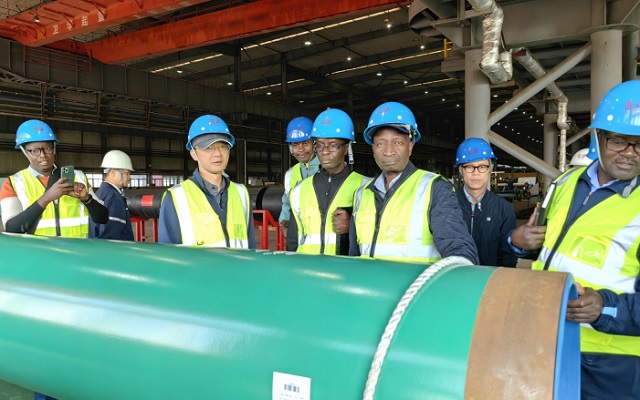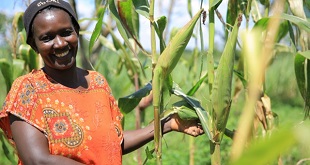
Petroleum Authority bosses visit China to verify and validate quality
Kampala, Uganda | RONALD MUSOKE | Panyu Chu Kong (PCK) Steel Pipe Co., Ltd, the Chinese company contracted to supply line pipes to the East Africa Crude Oil pipeline (EACOP) has said the first batch of 100 kilometres of pipes are now ready for shipping to the port of Tanga, in Tanzania.
This, sounds like good news to both President Yoweri Museveni’s government and the international oil partners, TotalEnergies and China National Offshore Oil Corporation (CNOOC) which have already began drilling of production wells for both the Tilenga and Kingfisher projects. Production and commercialisation of Uganda’s oil has been scheduled for 2025.
“We are committed to ensuring timely delivery and high-quality pipes,” Xie Leshan, the PCK President told a delegation of the Petroleum Authority of Uganda (PAU) during their verification and validation visit of the company in China towards the end of October.
The team led by Ernest Rubondo, the executive director of PAU visited PCK’s Pipe Mill in Lianyungang as part of a verification and validation visit to the Kingfisher Development project and East Africa Crude Oil pipeline (EACOP) Project activities in China, ahead of accelerated timelines for Uganda’s Oil projects.
The developers of the EACOP project are CNOOC Uganda Limited, TotalEnergies EP Uganda, Tanzania Petroleum Development Corporation (TPDC) and the Uganda National Oil Company (UNOC).
“The readiness of the first 100km of pipes for the EACOP is an indication of Government of Uganda and the oil companies’ commitment to deliver First Oil,” said Rubondo, “The achievement of these and other milestones is also as a result of the stable macroeconomic environment, and Uganda’s legal and institutional framework that has and continues to enable the oil industry to thrive.”
China’s Belt and Road Initiative
PAU’s visit coincided with the China’s Belt and Road Initiative forum. In a meeting at the CNOOC headquarters in Beijing, Rubondo told Liu Yongjie, the Chairman CNOOC International that their “meeting signified an important development in the ongoing collaboration between Uganda and China in the oil and gas sector.”
Liu and Rubondo discussed the progress of the Kingfisher project and received assurances of CNOOC’s commitment to fulfil its responsibilities on the project and expand cooperation to deliver a ‘shining star’ project in Uganda.
They also discussed strategies for the commercialisation of Uganda’s oil and gas resources and ways to maximize the in-country value generated by these projects, extending to local communities and national enterprises, thereby further enhancing economic growth and development.
Rubondo and Liu agreed that timely delivery of the project together with the development of national and community content are the best way to ensure a win-win situation from the Kingfisher project. The delegation also visited the Shougang Beijing Group’s Qian’an steel mill, which is supplying the steel plates used in the manufacturing of pipes.
“This is a crucial component of the project, as the quality and timely delivery of steel sheets are vital for the successful execution of the pipeline project which ensures the delivery of Kingfisher and Tilenga crude to Tanga for export,” Rubondo said.
The China visit symbolises the collaborative efforts between Uganda and China in the oil and gas sector, with a particular emphasis on the successful execution of key projects like the Kingfisher, Tilenga and the East African Crude Oil Pipeline.
“The visit is not only an exchange with CNOOC and its major contractors, but also an understanding of the achievements of Chinese-style modernisation and the Belt and Road Initiative. These collaborations not only have economic implications but also contribute to the development and growth of both nations’ oil and gas industries” he added.
The PAU delegation also met various companies that have been contracted by both TotalEnergies and CNOOC Uganda to undertake works and services on the oil and gas projects in Uganda. These contractors included COOEC (part of a joint venture undertaking the detailed engineering design, procurement, and construction of the Kingfisher project Central Processing facility and other facilities), COSL (drilling services), CENERTECH (Well completions tools, core cutting and fishing, drilling software and coating of the Kingfisher feeder pipeline) and CPP (construction of the EACOP pipeline and above ground installations).
The EACOP project
The EACOP, a US$ 3.5bn project, is one of the three major oil and gas infrastructure projects Uganda and its partners (TotalEnergies E&P Uganda, CNOOC Uganda Ltd, the Uganda National Oil Company [UNOC] and the Tanzania Petroleum Corporation [TPDC]) are determined to build ahead of commercialisation of Uganda’s petroleum resources in 2025.
The EACOP will have the capacity to pump up to 230,000 barrels of crude oil daily down a specially designed 1,443km-long ‘smart’ pipe from western Uganda to the Indian Ocean coastline of Tanzania.
Some parts of the pipe will be heat traced so that the high-grade, low Sulphur Ugandan crude, which is waxy at surface temperatures, will flow evenly. The pipeline, which will be buried along its length at up to 1.5 metres below the surface, will be lined with hi-tech insulation as well sensors and cut-off valves to minimize the risk of leakages.
The pipeline will be the longest heat-traced crude oil outlet in the world, at 1,443km, running from Kabaale in mid-western Uganda to the Tanga port on the Tanzanian Coast of the Indian Ocean. In Uganda, the pipeline covers 296km and crosses 10 districts, 22 sub-counties, four small towns, 41 parishes and 170 villages.
Thanks to its low sulphur content, the crude oil will require heating above 50oC to flow. Heating stations and a high voltage line to supply power are being planned alongside the pipeline.
Despite several re-assurance from oil companies and government officials from Uganda and Tanzania, environmental campaigners say the likely risk of oil spills from the pipeline pose a huge threat to the environment, wildlife, and livelihoods and welfare of tens of thousands of Ugandans and Tanzanians.
Opponents of the project further argue that it generate over 34 million extra tonnes of carbon emissions every year, accelerating the global climate crisis. Nearly a third of the pipeline will run through the Lake Victoria basin and an oil spill or leak could have catastrophic effects on these vital fresh water sources upon which more than 40 million people depend for water and food production.
The environmental campaigners say the likelihood of a spill or leak could not only result from accidental damage or poor maintenance but also because the pipeline will traverse an active seismic zone that regularly experiences earthquake.
On the #StopEACOP website, a dedicated platform for international climate justice campaigners, they say the French oil giant, TotalEnergies and the China National Offshore Oil Corporation (CNOOC) are on the brink of building a massive crude oil pipeline right through the heart of Africa that will tip the world closer to a full-blown climate catastrophe.
“It’s our job to highlight the risks, crank up the pressure in boardrooms and make sure EACOP is starved of the corporate and political support it needs,” the statement reads.
But, Ugandan officials at the Petroleum Authority of Uganda, led by Ernest Rubondo, have repeatedly noted that Uganda’s oil industry is being developed in a “smart manner with the global climate change crisis in mind.”
 The Independent Uganda: You get the Truth we Pay the Price
The Independent Uganda: You get the Truth we Pay the Price



